
Asplenium is a genus of about 700 species of ferns, often treated as the only genus in the family Aspleniaceae, though other authors consider Hymenasplenium separate, based on molecular phylogenetic analysis of DNA sequences, a different chromosome count, and structural differences in the rhizomes. The type species for the genus is Asplenium marinum.

Adiantum, the maidenhair fern, is a genus of about 250 species of ferns in the subfamily Vittarioideae of the family Pteridaceae, though some researchers place it in its own family, Adiantaceae. The genus name comes from Greek, meaning "unwetted", referring to the fronds' ability to shed water without becoming wet.
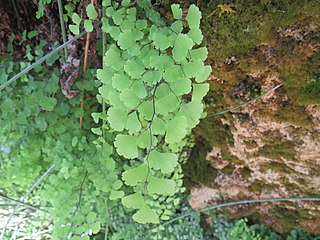
Adiantum capillus-veneris, the Southern maidenhair fern, black maidenhair fern, maidenhair fern, and venus hair fern, is a species of ferns in the genus Adiantum and the family Pteridaceae with a subcosmopolitan worldwide distribution. It is cultivated as a popular garden fern and houseplant.

The Huntsville Botanical Garden is a 118 acres (480,000 m2) botanical garden located at 4747 Bob Wallace Avenue, Huntsville, Alabama, near the U.S. Space & Rocket Center. It is open year-round for a fee. The garden is ranked third on the list of Alabama's top paid tourist attractions, receiving 353,841 visitors in 2018.

Adiantum aleuticum, the western maidenhair fern or Aleutian maidenhair, is a species of deciduous fern in the genus Adiantum.

Adiantum bellum is a species of fern in the family Pteridaceae, and is native to Bermuda.

Lygodium microphyllum is a climbing fern originating in tropical Africa, Southeast Asia, Melanesia and Australia. It is an invasive weed in Florida where it invades open forest and wetland areas. The type specimen was collected in the vicinity of Nabúa, on the island of Luzon in the Philippines by Luis Née.

Adiantum jordanii is a perennial species of maidenhair fern, in the Vittarioideae subfamily of the Pteridaceae. The species is known by the common name California maidenhair.
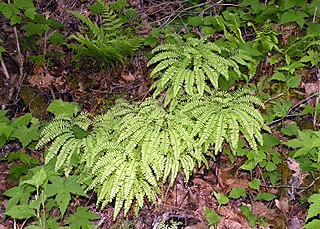
Adiantum pedatum, the northern maidenhair fern or five-fingered fern, is a species of fern in the family Pteridaceae, native to moist forests in eastern North America. Like other ferns in the genus, the name maidenhair refers to the slender, shining black stipes.
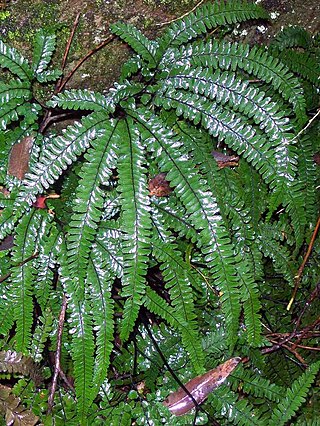
Adiantum hispidulum, commonly known as rough maidenhair fern or five-fingered jack, is a small fern in the family Pteridaceae of widespread distribution. It is found in Africa, Australia, Polynesia, Malesia, New Zealand and other Pacific Islands. Its fronds rise in clumps from rhizomes among rocks or in the soil in sheltered areas.
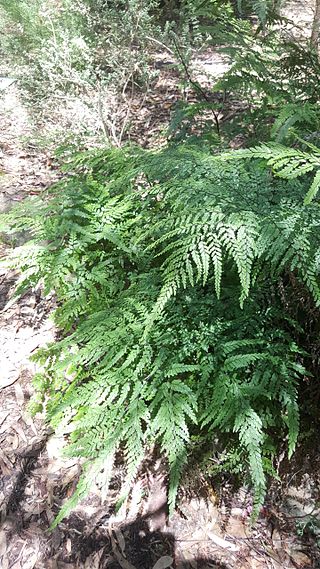
Adiantum formosum, known as the giant maidenhair or black stem maidenhair is a fern found in Australia and New Zealand. It was one of the many species authored by Scottish botanist Robert Brown, appearing in his 1810 work Prodromus Florae Novae Hollandiae et Insulae Van Diemen. Its species name is the Latin adjective formosus "handsome" or "beautiful".
Adiantum vivesii is a rare species of maidenhair fern known by the common name Puerto Rico maidenhair.

Adiantum viridimontanum, commonly known as Green Mountain maidenhair fern, is a fern found only in outcrops of serpentine rock in New England and Eastern Canada. The leaf blade is cut into finger-like segments, themselves once-divided, which are borne on the outer side of a curved, dark, glossy rachis. These finger-like segments are not individual leaves, but parts of a single compound leaf. The "fingers" may be drooping or erect, depending on whether the individual fern grows in shade or sunlight. Spores are borne under false indusia at the edge of the subdivisions of the leaf, a characteristic unique to the genus Adiantum.

Asplenium adiantum-nigrum is a common species of fern known by the common name black spleenwort. It is found mostly in Africa, Europe, and Eurasia, but is also native to a few locales in Mexico and the United States.

Adiantum raddianum, the Delta maidenhair fern, is one of the most popular ferns to grow indoors. It is native to South America and its common name comes from its shiny, dark leafstalks that resemble human hair. It typically grows about 17–19 in (43–48 cm) tall and up to 22 in (56 cm) wide. In the wild, it is found on forest floors, rock crevices, river banks, coastal cliffs, and basalt banks along trails and streams. The triangular fronds are semi-erect in the beginning then droop gracefully as they age and can be up to 12 inches (30 cm) long by 6 inches (15 cm) wide. The genus name Adiantum comes from the Greek word "adiantos", meaning "unwetted".
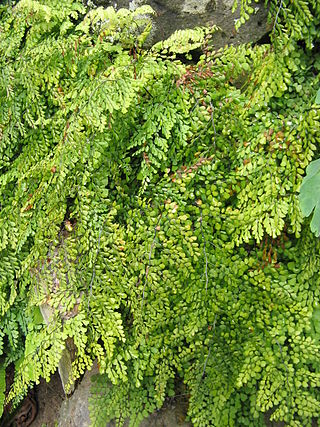
Adiantum venustum, the evergreen maidenhair or Himalayan maidenhair, is a species of fern in the genus Adiantum of the family Pteridaceae, native to China and the Himalayas. It is a slow to establish plant that usually grows on moist rocks and soil with a good amount of humus and dead leaves. It is very hardy, largely evergreen to -10 °C, when it becomes deciduous. It is also known as black Hansraj in India for its black stalks at the fronds.

Adiantum philippense,, also known as walking maidenhair fern, or black maidenhair, is a species of maidenhair fern (Adiantum) that is widely distributed through the southern hemisphere, notably Asia, Africa, and Madagascar.

Adiantum reniforme is a species of fern in the genus Adiantum (maidenhairs), family Pteridaceae. It grows in sheltered rock crevices and on walls. It is native to East Africa, Madagascar, the Mascarene Islands, Comoros and the Madeira, Canary and Cape Verde islands, plus a few relictual stations in the Tibesti (Chad).
Adiantum × mairisii is a species of fern in the family Pteridaceae.

















